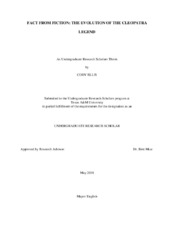| dc.description.abstract | Literature Review: There have been many attempts to reconstruct Cleopatra over the past two millennia, in the form of cultural depictions and histories, each of these adding a little more nuance to her mythology. The earliest depictions as a villainess hell bent on the destruction of the Roman Empire have received varied treatments over the years, but the general trend has been to depict Cleopatra more favorably. However, Cleopatra presents apologists of her legend with a significant problem in the sources for her lifetime. The earliest relatively complete accounts of Cleopatra’s lifetime come from biased Roman accounts. Adaptors then wanting to depict Cleopatra in a positive light must contend with the Roman bias in separating the fact from the fiction. However, the most iconic episodes of the Cleopatra Legend come from these very sources, suggesting that adaptors are not quite willing to part wholly with the Roman accounts. While there has been a general shift towards depicting Cleopatra more positively over the years, this is done while preserving much of the source material in cultural memory in how her legend is told. This desire to express Cleopatra differently, yet keep the terms through which she is portrayed, her iconic myths and episodes, the same is a peculiar case. From the surviving contemporary and near contemporary accounts of Cleopatra, most maintain a severe bias against her character. This is, in part, due to the fact that these accounts rely heavily on compiling the products of a propaganda war Augustus Caesar issued on Cleopatra as their sources. As a result, adaptors of the Cleopatra Legend are tasked with dealing with the Roman narrative of Cleopatra’s character, as there is little else material which meaningfully contributes to a full account of her lifetime. But why is it that if the earliest available accounts are known to be biased, fictitious, and embellished, that adaptors still seem to be burdened with maintaining the same narratives as closely as they do? In recent scholarship, histories have been constructed which describe the myths that have persisted throughout the entire Legend of Cleopatra and the various other myths that have generated over time within the legend. The works of Sally-Ann Ashton has been of particular importance in terms of creating a spectrum of the various Cleopatra’s that exist in many different cultural traditions. The research for this paper has been greatly supported by Ashton’s book, Cleopatra and Egypt, which offers a somewhat comprehensive survey of the topics of discourse surrounding the Cleopatra mythology, and from which I derive the general themes discussed in the analysis of my thesis. While a great number of Cleopatra adaptations are used in the analysis of this project (including books, rhetoric, plays, film, and video games), the thesis focuses on the adaptations by Chaucer, Shakespeare, Mankiewicz, and their contemporaries, in order to better understand how Cleopatra Legend is handled differently in each culture. Thesis Statement: By observing the evolution of Cleopatra VII's portrayals in literature, plays, art, and film, I chart the processes by which myths adapt and translate over time, across media and genres, and through cultural boundaries. This is accomplished through close readings of the works of Chaucer, Shakespeare, and Mankiewicz, as well as their contemporaries. This study aims to answer why apologists of Cleopatra's character still use Roman accounts as sources for reconstructions of the Cleopatra legend, despite the typical Roman bias against Cleopatra within these accounts. In answering this question, we observe the reasons Cleopatra's narrative has remained relatively unchanged in cultural depictions for the better part of two millennia. Theoretical Framework: This research is done by applying deriving from Jacques Derrida’s theory of translation and theory of transadaptation and then expanding it to include second order signs through Roland Barthes’ analysis of myth, and then applying it to a series of close readings of culturally significant transadaptations of the Cleopatra Legend. Project Description: This project offers a case study on the progression of the Cleopatra Legend from the time of biased Augustan political works to modern day film. While the works of many different genres, media, time periods and regions are taken into consideration, the thesis is organized by the analysis of Chaucer, Shakespeare, and Mankiewicz. The focus of this analysis answers why adaptors often chose not to depict Cleopatra as the early Romans did, while still maintaining the same narratives created in early Roman works. I believe the key to understanding this relationship involves the analysis of how mythologies are built and how they become cultural fact within society, which adaptations subsequently appeal to. This study explores through a derivation of Derrida’s theory of translation and an expansion on Barthes’ theory of myths, how the general shift toward more positive depictions of Cleopatra over time, combined with the continued use of biased Roman sources, is explained through Derrida’s economic laws of property and quantity combined with a linguistic law of convenience. | en |


